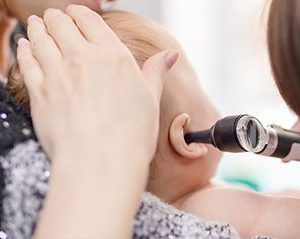- Navigating Your Midlife Crisis: Embracing New Possibilities
- City Raccoons Showing Signs of Domestication
- Mapping the Exposome: Science Broadens Focus to Environmental Disease Triggers
- One Week Less on Social Media Linked to Better Mental Health
- Your Brain Changes in Stages as You Age, Study Finds
- Some Suicide Victims Show No Typical Warning Signs, Study Finds
- ByHeart Formula Faces Lawsuits After Babies Sickened With Botulism
- Switch to Vegan Diet Could Cut Your Greenhouse Gas Emissions in Half
- Regular Bedtime Does Wonders for Blood Pressure
- Dining Alone Could Mean Worse Nutrition for Seniors
What Works Best to Ease Recurrent Ear Infections in Kids?

Frequent middle-ear infections are the nemesis of many parents and young children. Now a new study suggests that a common treatment — “ear tubes” — may not prevent future bouts.
Middle-ear infections (or acute otitis media) are second only to the common cold in creating childhood misery. They occur when the air-filled space behind the eardrum becomes infected and fills with fluid — which can cause pain, fever and obstructed hearing.
Some babies and young children are prone to frequent infections. One treatment option is to surgically place a tiny tube in the eardrum, to help drain fluid built up behind it.
But the new study, published May 13 in the New England Journal of Medicine, found that the tactic did not thwart future infections.
Among 250 babies and toddlers researchers followed, those treated with ear tubes suffered about as many middle-ear infections over the next two years as those who received only antibiotics for each bout.
The good news is that infections in both groups dissipated over time, said lead researcher Dr. Alejandro Hoberman of UPMC Children’s Hospital of Pittsburgh.
Kids normally outgrow the infections, he explained. Babies and toddlers are prone to them because of the structure of their eustachian tubes, which help drain fluid from the middle ear. As little ones grow older, that changes.
According to Hoberman, the new findings suggest that for many children, tubes can be avoided.
But, he added, some may need tubes if their rate of ear infection does not wane over time.
Dr. Steven Sobol is chairman of the American Academy of Pediatrics’ Section on Otolaryngology-Head and Neck Surgery.
He said the study “supports the well-established belief that many children with recurrent acute otitis media eventually grow out of their symptoms, regardless of whether they’ve been managed medically or surgically.”
But decisions on treatment, Sobol said, depend on various factors. They include whether infections are impairing a child’s hearing and speech development.
That point was emphasized by Dr. Maura Cosetti of Mount Sinai’s New York Eye and Ear Infirmary in New York City.
“The age of children in the study … coincides with what’s felt to be the sensitive period for speech and language development,” Cosetti said.
Unlike antibiotics, she explained, ear tubes “may provide immediate relief from hearing loss related to middle-ear fluid — the value of which may be difficult to quantify in the current study.”
To Sobol, the study “emphasizes the importance of creating an individualized approach to management.”
The trial included 250 children, ages 6 months to nearly 3 years, who had suffered recurrent middle-ear infections — at least three within six months, or four within a year.
Hoberman’s team randomly assigned them to have either an ear tube surgically placed or receive oral antibiotics whenever a new infection struck.
Kids given ear tubes also received antibiotics when a new infection arose — but by ear drop. If that didn’t work, they switched to oral antibiotics.
One potential advantage of ear tubes, Hoberman noted, is that they allow ear-drop antibiotics. That could reduce the risk of bacteria elsewhere in the body developing antibiotic resistance.
Over the two-year study, though, there was no clear advantage of ear tubes when it came to new infections, or antibiotic resistance.
The average rate of recurrent ear infection was around 1.5 per year in the ear-tube group, and 1.7 in the comparison group. Infections declined in the second year in both groups.
Children with ear tubes did spend fewer days on oral antibiotics, the study found.
But the two treatment groups showed no difference in the likelihood of harboring antibiotic-resistant bacteria in the nose or throat.
Still, Sobol pointed out, there were some other advantages in ear-tube group.
For one, they tended to remain infection-free longer before their first recurrence. They also generally had fewer days with infection symptoms — with the exception of drainage from the ear.
At the same time, Hoberman said, ear tubes carry risks, albeit small. During the procedure, there can be bleeding or reactions to the anesthesia. In the longer term, the tube can become blocked or cause structural changes in the eardrum.
In the end, Sobol said, the treatment choice should be decided case by case.
To help prevent middle-ear infections in the first place, Hoberman said, babies should receive the routine pneumococcal vaccine. Breastfeeding and protecting youngsters from second-hand smoke can also reduce the risk, he said.
More information
The Nemours Foundation has more on middle-ear infections.
SOURCES: Alejandro Hoberman, MD, director, general academic pediatrics, UPMC Children’s Hospital of Pittsburgh, and professor, pediatric research, University of Pittsburgh School of Medicine; Maura Cosetti, MD, director, Cochlear Implant Center, New York Eye and Ear Infirmary of Mount Sinai, New York City; Steven Sobol, MD, MSc, chairman, Section on Otolaryngology-Head and Neck Surgery, American Academy of Pediatrics, Itasca, Ill.; New England Journal of Medicine, May 13, 2021
Source: HealthDay
Copyright © 2025 HealthDay. All rights reserved.










